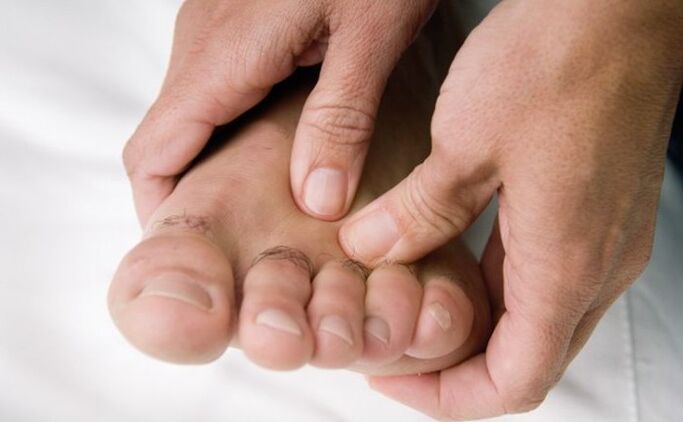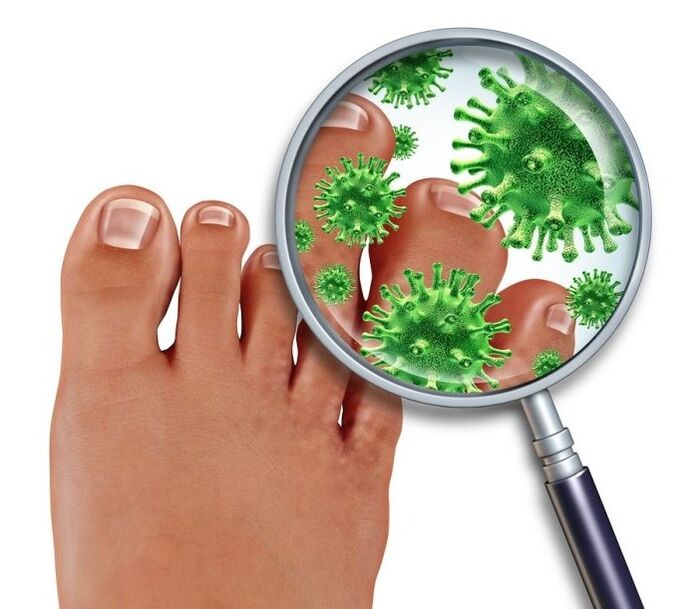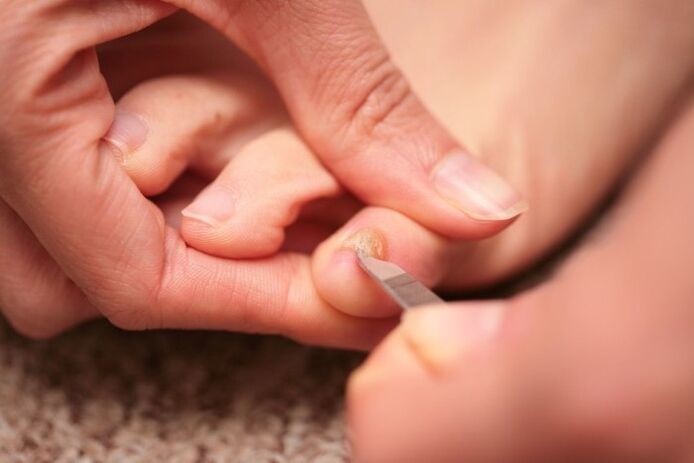The question of how to treat nail fungus is asked by many, but not everyone chooses the right solution to this problem and only resort to traditional medicine. The use of home-made products can sometimes be beneficial, but it is better to trust the experts and not to experiment with your own health.

Another misconception is that nail fungus is not a serious disease that should be treated immediately, but it is far from the case. Fungal or onychomycosis is associated with the spread of bacteria in the cornea, and if they do not prevent their spread, the infection will penetrate all surrounding tissues and the body. In this case, you need to decide not how much the nail fungus needs to improve, but how to get rid of the joint and overall health.
How the fungus manifests itself
It is easier to fight the infection in the early stages. It is possible to avoid the use of special therapeutic agents and prevent the destruction of the nail, leading to complete or partial removal of the corneal plaque.
In principle, anyone who pays attention to their feet and takes care of their toes regularly can detect a fungal infection. This is evidenced by the following symptoms:
- Appearance of areas that differ from the natural color of the nail. What the changes will depend on the type of infection. These can be light stripes or brown, yellow "dots". There must be a reason to find the cause of the appearance of such changes, other shades are likely to occur;
- Elegance. If the nail is shed or broken, it is probably time to decide how to treat nail fungus. In some cases, broken nails are caused by other diseases, vitamin deficiencies and poor nutrition, so in any case it does not hurt to consult a specialist;
- Deformation of the cornea. Bacterial growth, lack of treatment causes significant changes in the nail, causing significant deformation. Not only does the appearance of the foot deteriorate, but it also causes discomfort when walking in shoes;
- Itching, pain in the affected area;
- Bad smell. It is highly undesirable to bring the condition of the nails to the stage at an inflammatory stage, when a certain odor is already spread, when there are signs of milk. Such symptoms may indicate that it is not already time to treat nail fungus, but that the body is taking steps to prevent the spread of infection.
Symptoms have different manifestations depending on the development of nail disease, which leads to the appropriate classification of mycotic lesions:

- 1st stage. An initial degree that can only be detected by a very careful person or a specialist dermatologist. Small discoloration, slight itching is possible;
- Phase II. The nail may be deformed, change color, the stratum corneum is partially destroyed. There is still an opportunity to treat nail fungus without surgery, but the delay will only aggravate the situation;
- Phase III. It is considered one of the most advanced degrees of fungal infection. It is no longer necessary to treat not only the nail, but also the surrounding tissues and the root itself, because at this stage the infection is very deep. Various inflammations, swelling, etc. It can also become a factor. It is very dangerous to bring the condition of the legs to such an advanced stage, because the treatment will require significant physical and financial costs, and there is no guarantee that the restored nail will be equal.
What can be the treatment of athlete's foot
Modern medicines for various infections on the market for medical products allow you to effectively treat the fungus at home. Depending on the stage, type and degree of infection, it is possible to choose the optimal drug.
In addition, some drugs have a complex effect, the use of which allows you to decide not only how to treat nail fungus, but also how to stimulate cell renewal and accelerate healing.
The following subgroups can be distinguished from many medications that are actively advertised, have positive reviews, or are simply recommended for nail diseases:
- Good luck. However, as an additional treatment, it is recommended to use, for example, at a time when the use of ointments, compresses or other external means is not possible. There are varnishes that help to gradually erode the affected area, which is necessary for better penetration of active compounds to destroy the infection. The main advantage of varnishes is the ability to mask the fungus, as a temporary decorative varnish can be applied over the therapeutic varnish. Consideration of such solutions is controversial; it is not recommended to use varnish in advanced stages;
- Damla. The solutions are also applied to the cleaned nail or after removal so that the active compounds penetrate the infected area. If there is significant damage to the nail, it is prescribed in combination with other drugs;
- Ointments and creams. The most diverse range of medicines are ointments and special creams. They differ not only in efficiency and mobility, but also in price. As part of each drug, the active ingredients, concentration and possible side effects are indicated. Since bacteria (yeasts, dermatophytes), which differ in the type of activity, can provoke fungi, methods of combating them should be chosen accordingly. There are complex action ointments and creams, ie they are allowed to use for various infections. The ointment can help prevent infection from spreading and help you heal better. The purpose of such drugs differs from the recommendation of their use for nail removal and ends with the usual prophylaxis. In this regard, it is better to consult a specialist before use, analyze, carefully read the instructions to get rid of the fungus in the near future;
- Band-assistants. It is mainly used for partial or complete removal of nails. Such a procedure is necessary with advanced stages, because the patient is unable to restore a nail. The patch is impregnated with special substances that slowly dissolve the stratum corneum affected by the infection. After several applications, it is enough to clean the nail from the peeled particles and apply a medicated ointment. All of this is easy to do at home;
- Oral preparations. If the infection does not spread to just one nail, it is advisable to use special medications if there is a risk of infection. In practice, such treatment is mainly prescribed in stage III. In addition to antifungal suspensions or tablets, a vitamin-mineral complex can be prescribed to protect the functions of the whole body and increase the properties of immunity.

In addition to home remedies, you can also use the equipment to get rid of the fungus. These include laser therapy, cosmetic procedures combined with the application of solutions to eliminate the source of infection, to restore the nail in a natural way.
You can choose a drug for the treatment of spontaneous fungal infections of the nails. This is facilitated by the media, advertising in pharmacies, the recommendations of a pharmacist, reviews on the Internet. The best option to avoid mistakes is to consult a doctor. However, in this case, you can ask about alternative treatments, because there are funds that have a similar composition, but differ significantly in terms of disease.
If the medication is chosen correctly, the improvements will be noticeable after a while. When the pulsation, redness, onychomycosis already progresses in other areas, there is an unpleasant odor, then you should immediately contact a specialist. Self-medication with such phenomena can be more dangerous.
Traditional medicine in the fight against nail fungus
A few decades ago, there was no universal remedy for the complex treatment of a fungus, there was no way to find reviews about drugs, and then traditional medicine was used mainly in prescriptions. Iodine was especially popular, and it is still an excellent prophylactic solution against the spread of infections of various origins. One of the most common ways to treat mycosis at home is:
- Hot baths. Solutions are prepared with different components, but the actions are mainly aimed at softening and disinfecting the affected area. A good effect can be achieved with a bath of sea salt, diluted vinegar, celandine, weak potassium permanganate. Each of the options has a certain effect, there is a possibility of an allergic reaction. Often, after such procedures, it is recommended to mechanically clean the nail (with a special brush, pumice stone), apply iodine or a special medical antifungal drug;
- Vinegar. It is believed that a vinegar solution fights such lesions well, the main thing is to dilute the suspension in the right proportions and not to burn the already damaged tissue;
- Compresses. Different products are used for such procedures. This includes water, potatoes, garlic, chopped onions, aloe leaves, gargle, mountain ash and more. It is a baking powder diluted with. While doing such experiments, you need to understand a number of serious consequences, including an acquired allergy, burns, or the most harmless outcome - no effect;
- Essential oils, herbal solutions. Essential oils, especially tea tree oil, are a natural antiseptic. It can be used during treatment, but also as a foot protection or cosmetic treatment. Marjoram, eucalyptus oil is also used;
- Salicylic acid can be used to combat onychomycosis, but mainly in the early stages of lesion development.
The appropriateness of using home remedies is debatable. Because for some such treatment is successful, and for others it improves not only the nail, but also the health in general for a long time.
How to prevent nail fungus or not infect others
Knowing certain rules will help reduce the risk of an unpleasant nail infection, as well as protect your loved ones and other people from infection if the question of how to treat mycosis is already decided.
The basic rules for protection and prevention of fungi are as follows:
- Regular hygiene, personal detergents;
- Use of special slippers in public places (saunas, swimming pools);
- Strengthening the immune system. The weakened body is unable to fight the infection and the infection spreads;
- Cleaning and periodically disinfecting shoes, especially if the feet sweat frequently;
- The cleanliness of the sock should be changed daily, natural fabrics should be preferred;
- Wipe your feet thoroughly after water treatments, high humidity causes the development of fungi;
- Use only your own shoes and clothes;
- Periodic disinfection of tools for pedicure or manicure and, of course, their individual use only. If we compare professional offices, special sterilizers are used for this purpose;
- Proper foot care. In addition to regular cleaning of the feet with special devices, it is necessary to nourish the skin of the feet and nails. If possible, you should visit beauty salons where professional nail treatments, horn boards and skin supplementation are performed.
These simple rules, accuracy and attention to your health will help you avoid more problems associated with the treatment of mycosis. If the disease is already being treated, similar rules should be followed. This will help prevent other people from becoming infected and speed up the healing process.
If an infection with a fungus occurs, it may not appear immediately, sometimes after a few months. It is important to detect the presence of an infection focus in time and take measures to help maintain the health and beauty of the legs.
























